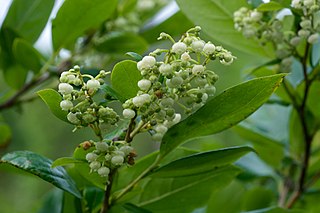Isoetes louisianensis, the Louisiana quillwort, is a small, grass-like aquatic plant of the family Isoetaceae. It is "one of the rarest quillworts in North America." It occurs in only five locations in St. Tammany and Washington Parishes of Louisiana and some spots in southern Mississippi. It is federally listed as an endangered species, partly due to its highly restricted range.

Xerophyllum asphodeloides is a North American species of flowering plants in the Melanthiaceae known by the common names turkey beard, eastern turkeybeard, beartongue, grass-leaved helonias, and mountain asphodel. It is native to the eastern United States, where it occurs in the southern Appalachian Mountains from Virginia to Alabama, and also in the Pine Barrens of New Jersey.

Nepenthes truncata is a tropical pitcher plant endemic to the Philippines. It is known from the islands of Dinagat, Leyte, and Mindanao. The species grows at an elevation of 0–1500 m above sea level. Nepenthes truncata is characterised by its heart-shaped (truncate) leaves and very large pitchers, which can reach up to 40 cm in height.

Florida sand pine scrub is an endangered subtropical forest ecoregion found throughout Florida in the United States. It is found on coastal and inland sand ridges and is characterized by an evergreen xeromorphic plant community dominated by shrubs and dwarf oaks. Because the low-nutrient sandy soils do not retain moisture, the ecosystem is effectively an arid one. Wildfires infrequently occur in the Florida scrub. Most of the annual rainfall falls in summer. It is endangered by residential, commercial and agricultural development, with the largest remaining block in and around the Ocala National Forest. Lake Wales Ridge National Wildlife Refuge also holds a high proportion of remaining scrub habitat, while the Archbold Biological Station near Lake Placid contains about 20 km2 (7.7 sq mi) of scrub habitat and sponsors biological research on it.

Lyonia is a genus of flowering plants in the family Ericaceae. There are about 35 species native to Asia and North America.

Telopea truncata, commonly known as the Tasmanian waratah, is a plant in the family Proteaceae. It is endemic to Tasmania where it is found on moist acidic soils at altitudes of 600 to 1200 m (2000–4000 ft). Telopea truncata is a component of alpine eucalypt forest, rainforest and scrub communities. It grows as a multistemmed shrub to a height of 3 metres (10 ft), or occasionally as a small tree to 10 m (35 ft) high, with red flower heads, known as inflorescences, appearing over the Tasmanian summer and bearing 10 to 35 individual flowers. Yellow-flowered forms are occasionally seen, but do not form a population distinct from the rest of the species.

Haworthia truncata, locally known as horse's teeth, is a species of succulent plant in the genus Haworthia. It is found in the Little Karoo region, in the far east of the Western Cape Province, South Africa.

Vernonia proctorii is a rare species of flowering plant in the aster family known by the common name Proctor's ironweed. It is endemic to Puerto Rico, where there are two populations. It is threatened by the destruction of its habitat. It is a federally listed endangered species of the United States.

Eubotrys racemosa is a species of flowering plant in the heath family known by the common names fetterbush, swamp doghobble, and swamp sweetbells.

Lyonia ligustrina is a species of flowering plant in the family Ericaceae known by the common names maleberry and he-huckleberry. It is native to the eastern United States from Maine to Florida and west to Texas and Oklahoma.

Lyonia lucida is a species of flowering plant in the family Ericaceae known by the common names fetterbush lyonia, hurrahbush, and staggerbush. Other plants may also be called fetterbush. This broadleaved evergreen plant grows on the coastal plain of the southeastern United States from Virginia to Florida to Louisiana. It also occurs in Cuba.
The south Florida pine flatwoods are a flatwoods forest community found in central and southern Florida.

Lyonia fruticosa, the poor-grub or coastal plain staggerbush, is a plant species native to the US states of Florida, southern Georgia and the extreme southern part of South Carolina. It grows in pine woodlands and shrub bogs at elevations less than 100 meters.

Brazoria truncata, common name rattlesnake flower, is a plant species in the family Lamiaceae, first described in 1834. It is endemic to Texas, found in the south-central and eastern parts of the state.

Haworthia cooperi is a diverse and varied species of the genus Haworthia in the family Asphodelaceae, endemic to the Eastern Cape Province in South Africa.

Portlandia coccinea is a small tree or shrub with bright red flowers endemic to Jamaica. The species was first described in 1788. A population with darker flowers had been considered a subspecies of P. coccinea, but was described as a separate species, P. proctori, in 2003.

Lyonia mariana, the Piedmont staggerbush and staggerbush, is a perennial shrub that is native to the United States.

Lyonia ferruginea, the rusty staggerbush, tree lyonia, dragon tree, is a plant of the genus Lyonia. It was first described by Thomas Walter, and was named by Thomas Nuttall. No subspecies are listed in the Catalog of Life.
















